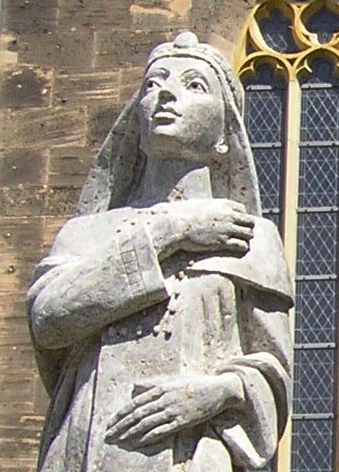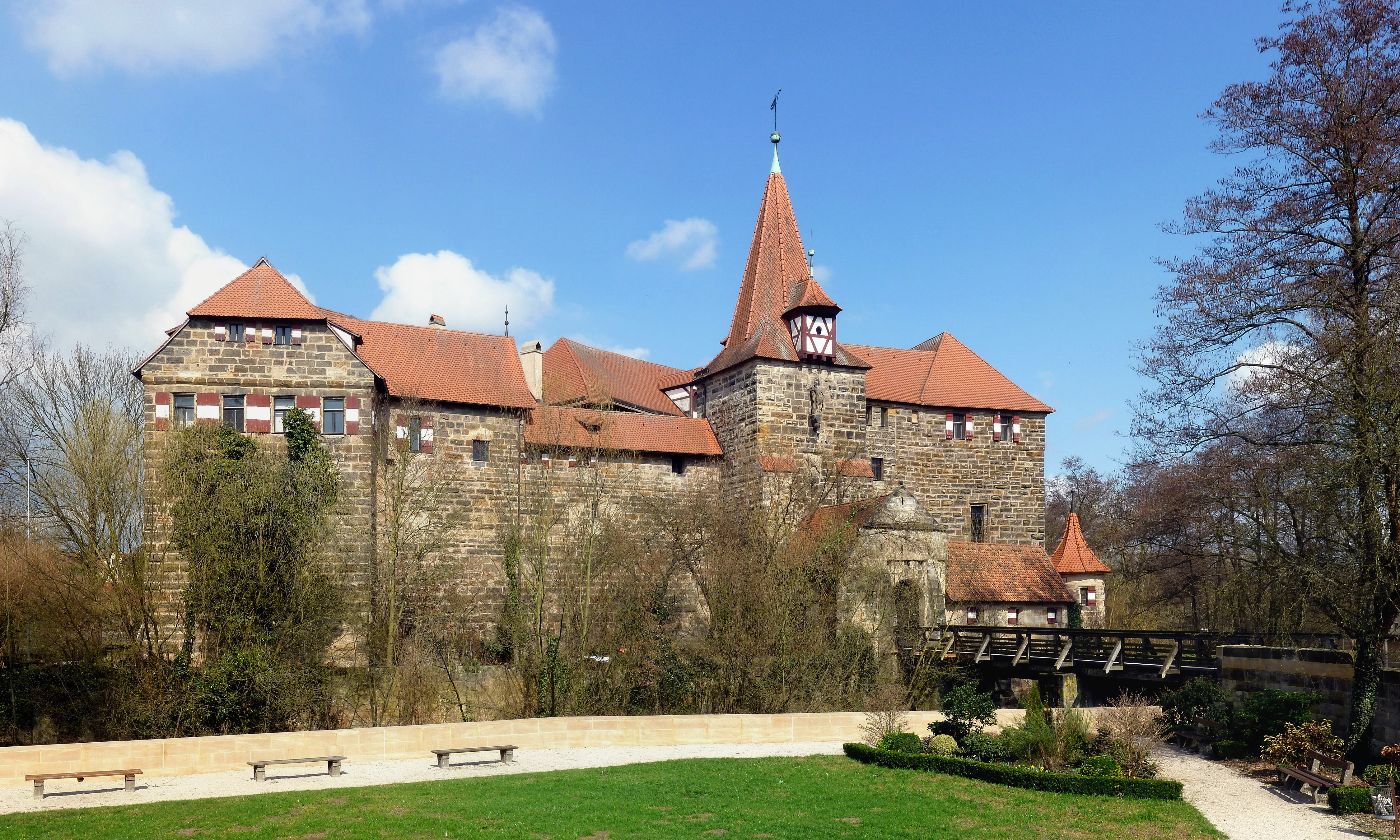|
Anna Svídnická
Anna of Schweidnitz (Świdnica) (also known as Anne or Anna of Świdnica, , , ) (Świdnica, 1339 – 11 July 1362 in Prague) was Queen of Bohemia, German Queen, and Empress of the Holy Roman Empire. She was the third wife of Emperor Charles IV. Biography Anne was the daughter of Polish Duke Henry II of Świdnica-Jawor from the Silesian branch of the Piast dynasty. Her mother was Katherine of Hungary (hypothesis disproved), the daughter of Charles I of Hungary. In his autobiography written in Latin, which covers only his youth prior to marrying Anna, emperor Charles mentions ''civitatem Swidnitz'' and ''dux Swidnicensis'', as depicted in the coat of arms room of his Wenzelschloss castle at Lauf an der Pegnitz near Nuremberg. Anne's father died when she was four years old, and her childless uncle, Bolko II, Duke of Świdnica-Jawor became her guardian. She was brought up and educated by her mother at Visegrád in Hungary. At the age of 11, Anne had been promised to Wenceslau ... [...More Info...] [...Related Items...] OR: [Wikipedia] [Google] [Baidu] |
List Of Holy Roman Empresses
The Holy Roman Empress or Empress of the Holy Roman Empire (''Kaiserin des Heiligen Römischen Reiches'') was the wife or widow of the Holy Roman Emperor. The elective dignity of Holy Roman emperor was restricted to males only, but some empresses, such as Theophanu and Maria Theresa, were '' de facto'' rulers of the Empire. Holy Roman Empresses Before 924, the title of emperor was not always associated with the German kingdom; rather, it was initially associated with the Carolingian dynasty, and then possessed by several other figures of the 9th and 10th centuries. Their wives were thus empresses, but not necessarily German queens. Carolingian Holy Roman Empresses/Queens of Germany With the elevation of Otto I of Germany in 962 to the Imperial title, the title of Roman King or Emperor became inalienably associated with the Kingdom of Germany - although a King of Germany might not bear the title of Emperor, it would be impossible to become a Holy Roman Emperor without being Ki ... [...More Info...] [...Related Items...] OR: [Wikipedia] [Google] [Baidu] |
Jawor
Jawor () is a town in south-western Poland with 22,890 inhabitants (2019). It is situated in the Lower Silesian Voivodeship. It is the seat of Jawor County, and lies approximately west of the regional capital Wrocław. One of the oldest towns in the region, with a history of more than a thousand years, Jawor was one of the main centers of weaving in Silesia and, in 1274–1392, the capital of an eponymous principality ruled by a local line of the Piast dynasty. It has a preserved medieval urban layout with several Gothic, Renaissance and Baroque structures, including the Church of Peace, a Historic Monument of Poland and UNESCO World Heritage Site. Jawor is the site for electrical machinery, chemical, paper and food industries, and there are numerous granite and basalt quarries near the town. Through the town flows the 31 mile long Raging Nysa river (pl: ''Nysa Szalona''). Etymology The name of the city ''Jawor'' comes from the Polish word for " sycamore maple." The earlie ... [...More Info...] [...Related Items...] OR: [Wikipedia] [Google] [Baidu] |
Pope Innocent VI
Pope Innocent VI (; 1282 – 12 September 1362), born Étienne Aubert, was head of the Catholic Church and ruler of the Papal States from 18 December 1352 to his death, in September 1362. He was the fifth Avignon pope and the only one with the pontifical name of "Innocent". Étienne Aubert, born in the Diocese of Limoges, was a civil law professor and held various positions in the church before being appointed as Cardinal-Bishop of Ostia and Velletri by Pope Clement VI. He became Pope Innocent VI on 30 December 1352. As pope, he revoked an agreement asserting the college of cardinals' superiority over the pope and introduced important reforms in church administration. Through his legate, Cardinal Albornoz, he aimed to restore order in Rome. Innocent VI played a significant role in the 1360 Treaty of Brétigny between France and England. Though he declined an offer to unite the Greek Orthodox Church with the Roman See in exchange for support, his papacy was marked by financia ... [...More Info...] [...Related Items...] OR: [Wikipedia] [Google] [Baidu] |
Arnošt Of Pardubice
Arnošt of Pardubice (, ; 25 March 1297 – 30 June 1364) was the first List of bishops and archbishops of Prague, Archbishop of Prague (and the last bishop). He was also an advisor and diplomat to Emperor Charles IV, Holy Roman Emperor, Charles IV. Life Arnošt of Pardubice was probably born in Hostinka (today part of Vestec (Náchod District), Vestec), but possibly also in Kłodzko. He was the eldest son of Knight Arnošt of Hostinka, and spent his childhood in Kłodzko. Arnošt inherited the town of Pardubice in 1340. He was confirmed bishop of Prague on 11 March 1343 (3 March 1343 Julian calendar, O.S.), and was commissioned the first Archbishop of Prague on 8 May 1344 (30 April 1344 O.S.). He ordered the monks to contribute to the newly founded Charles University (14th century), hence enhancing the quality of the education in the institution. Further reading * * Jaroslav Polc: ''Ernst vom Pardubitz''. In: Ferdinand Seibt, ''Lebensbilder zur Geschichte der böhmischen Lä ... [...More Info...] [...Related Items...] OR: [Wikipedia] [Google] [Baidu] |
Louis I Of Hungary
Louis I, also Louis the Great (; ; ) or Louis the Hungarian (; 5 March 132610 September 1382), was King of Hungary and Croatia from 1342 and King of Poland from 1370. He was the first child of Charles I of Hungary and his wife, Elizabeth of Poland, to survive infancy. A 1338 treaty between his father and Casimir III of Poland, Louis's maternal uncle, confirmed Louis's right to inherit the Kingdom of Poland if his uncle died without a son. In exchange, Louis was obliged to assist his uncle to reoccupy the lands that Poland had lost in previous decades. He bore the title Duke of Transylvania between 1339 and 1342 but did not administer the province. Louis was of age when he succeeded his father in 1342, but his deeply religious mother exerted a powerful influence on him. He inherited a centralized kingdom and a rich treasury from his father. During the first years of his reign, Louis launched a crusade against the Lithuanians and restored royal power in Croatia; his troops ... [...More Info...] [...Related Items...] OR: [Wikipedia] [Google] [Baidu] |
Duchies Of Silesia
The Duchies of Silesia were the more than twenty divisions of the region of Silesia formed between the 12th and 14th centuries by the breakup of the Duchy of Silesia, then part of the Kingdom of Poland. In 1335, the duchies were ceded to the Kingdom of Bohemia under the Treaty of Trentschin. Thereafter until 1742, Silesia was one of the Bohemian crown lands and lay within the Holy Roman Empire. Most of Silesia was annexed by the King of Prussia under the Treaty of Berlin in 1742. Only the Duchy of Teschen, the Duchy of Troppau and the Duchy of Nysa remained under the control of the Bohemian crown and as such were known as the Duchy of Upper and Lower Silesia until 1918. States and territories disestablished in 1742 Breakup of Polish Silesia (1138–1335) In the (vain) hope to prevent an inheritance dispute, the Piast prince Bolesław III Wrymouth by his last will and testament had divided Poland into hereditary provinces distributed among his four sons: Masovia, Kujawy ... [...More Info...] [...Related Items...] OR: [Wikipedia] [Google] [Baidu] |
John I Of Bohemia
John of Bohemia, also called the Blind or of Luxembourg (; ; ; 10 August 1296 – 26 August 1346), was the Count of Luxembourg from 1313 and King of Bohemia from 1310 and titular King of Poland. He is well known for having died while fighting in the Battle of Crécy at age 50, after having been blind for a decade. In his home country of Luxembourg, he is considered a national hero. Comparatively, in the Czech Republic (anciently the Kingdom of Bohemia), Jan Lucemburský is often recognized for his role as the father of Charles IV, Holy Roman Emperor, one of the more significant Kings of Bohemia and one of the leading Holy Roman Emperors. Early life John was the eldest son of Henry VII, Holy Roman Emperor and Margaret of Brabant, who was the daughter of John I, Duke of Brabant and Margaret of Flanders. Born in Luxembourg and raised in Paris, John was French by education but deeply involved in the politics of Germany. In 1310, his father arranged the marriage of 14-y ... [...More Info...] [...Related Items...] OR: [Wikipedia] [Google] [Baidu] |
Anna Of Bavaria
Anne of Bavaria (or of the Palatinate; ; 26 September 1329 – 2 February 1353) was Queen of Bohemia by marriage to Charles of Luxembourg. She was the daughter of Rudolf II, Count Palatine of the Rhine, and Anna, daughter of Otto III of Carinthia. Life Anna was a member of the House of Wittelsbach. She married Holy Roman Emperor Charles IV on 11 March 1349 in the town of Bacharach on the Rhine. She became the second wife of Charles after the death of his first wife, Blanche of Valois, in 1348. On 26 July 1349 in Aachen, Anna was crowned Queen of Rome. Months later she was crowned Queen of Bohemia. In 1350, Anna gave birth to a son, Wenceslaus, who died one year later, in 1351. Anna did not have more children and died herself in 1353 at the age of 23. Charles was widowed for a second time and still had no son. He then married Anna von Schweidnitz, who gave birth to the desired heir, Wenceslaus, King of the Romans. Asteroid Asteroid 100733 Annafalcká, discov ... [...More Info...] [...Related Items...] OR: [Wikipedia] [Google] [Baidu] |
Lauf An Der Pegnitz
Lauf an der Pegnitz (, ; Northern Bavarian: ''Lauf an da Pegnitz'') is a town east of Nuremberg, Germany. It is the capital of the Nürnberger Land district in Bavaria. It is in the Pegnitz river valley, which flows through the town. In 2009, the municipality developed a climate protection plan which was supported by the German Ministry for the Environment. Twin towns – sister cities Lauf an der Pegnitz is twinned with: * Brive-la-Gaillarde, France * Drama Drama is the specific Mode (literature), mode of fiction Mimesis, represented in performance: a Play (theatre), play, opera, mime, ballet, etc., performed in a theatre, or on Radio drama, radio or television.Elam (1980, 98). Considered as a g ..., Greece * Nyköping, Sweden * Tirschenreuth, Germany Notable people * Hermann Roesler (1834–1894), economist * Martin Lauer (1937–2019), athlete, Olympic medalist, lived here * Martin Jellinghaus (born 1944), athlete, Olympic medalist * Marlene Mortler (born 1955), ... [...More Info...] [...Related Items...] OR: [Wikipedia] [Google] [Baidu] |
Wenzelschloss
Lauf Castle ( or ''Burg Lauf''; ) was originally a medieval fortress in the town of Lauf an der Pegnitz near Nuremberg, Germany. The German name ''Wenzelschloss'' ("Saint Wenceslas' Castle") is derived from to the present day surviving statue of Saint Wenceslas, patron saint of Czechs, on the facade of the entrance gate. The castle was built by the Charles IV, Holy Roman Emperor in 1356, on the way between Prague and Nuremberg on the ruins of an older castle. The dominant feature of the castle is the hall of arms; in 1934, under a layer of old paint were discovered 112 coats of arms of noblemen of the Crown of Bohemia. It is the most precious collection of Bohemian, Moravian and Silesian secular and ecclesiastical heraldry. [...More Info...] [...Related Items...] OR: [Wikipedia] [Google] [Baidu] |






